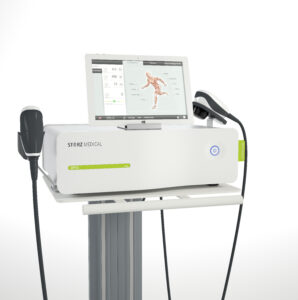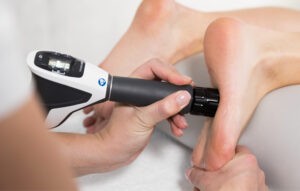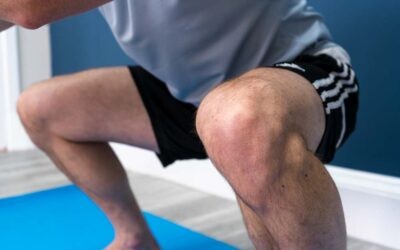Shockwave Therapy now available in Largs and Clarkston
Have you ever suffered with a chronic (long term) tendon problem? Have you tried a long rehab plan, stuck to it like glue and only partially recovered? Do you want to get rid of that annoying ache and not have to go through surgery or receive an injection? Are you fed up reaching for pain killers before going on court, before a round of golf or before going out a run? Are you hesitant to enjoy your sport or activity on consecutive days in case it gets too painful?
Well, then we have a new treatment available which could be perfect for you. It’s called Shockwave Therapy. We are delighted to be able to introduce Shockwave Therapy to our clinics in Largs and Clarkston, but what is shockwave and who can benefit?
What is shockwave treatment?
Shockwave is a treatment in which high-frequency pulses (energy) pass through soft tissue or bone to encourage engagement of the body’s natural recovery and healing process whilst offering an acute anaesthetic affect. Shockwave can be used to treat conditions with inflammation, or as a method to support nerve and tissue repair and regeneration. It is a non-invasive, safe method of treatment which can be used to successfully manage and treat a wide range of conditions. It is a commonly used alternative to surgery, providing impressive results throughout many patients.

Shockwave therapy available in Clarkston and Largs
How does shockwave work?
Shockwave is applied through a handheld device, which can either be focused specifically to one point or generally depending on the desired effect. The “shockwaves” or pulses produced by this device create movement within the cells of the targeted structures as they pass through them, encouraging an increase in cell activity. Within this increase, the cells request a higher demand for blood supply, helping with recovery. They also release additional beneficial chemicals which aid the recovery process and offer pain moderation.
So in summary shockwave therapy helps with 3 key responses:
- Reduces pain response
- Stimulates the repair and promotes tissue healing response
- Controls the inflammatory response to allow for a faster recovery
What conditions is shockwave good for?
Shockwave therapy is a non-invasive treatment option that uses high-energy sound waves to promote healing and reduce pain. It has been used for a variety of conditions, including chronic musculoskeletal pain, and is becoming increasingly popular as a treatment option.
One of the conditions that can benefit most from shockwave therapy is chronic plantar fasciitis, a common cause of heel pain. Studies have shown that shockwave therapy can be effective in reducing pain and improving function in individuals with chronic plantar fasciitis who have not responded to other conservative treatments. It is also used for chronic tendinopathies such as tennis elbow, jumper’s knee and calcific tendinitis of the shoulder. It is ideal for those who have not responded fully to traditional rehab but want to avoid surgery and injections.
Another condition that can benefit from shockwave therapy is chronic low back pain. Shockwave therapy has been shown to be effective in reducing pain and improving function in individuals with chronic low back pain caused by muscle or soft tissue conditions such as myofascial pain syndrome.
Shockwave therapy is also commonly used to treat chronic muscle and soft tissue conditions such as myofascial pain syndrome, which is characterised by pain and tenderness in the muscles and connective tissue. It is also used to treat chronic neck pain, chronic pelvic pain and chronic pain after surgery.
The conditions shockwave therapy is most effective for is listed below:
- Plantar Fasciitis
- Achilles Tendinopathy
- Tennis Elbow
- Golfers Elbow
- Rotator Cuff Tendinopathy
- Patella Tendinopathy
- Hamstring Tendinopathy
- Shin Splints
- Frozen Shoulder
- Greater Trochanter Pain Syndrome
+ others
We also have some great free resources available on our website. For example check out the free ebook “The 12 most common conditions which are stopping you from enjoying run or a walk (and what to do about them)” located on this link
https://optimalphysio.co.uk/foot-and-ankle-pain/

Shockwave is very effective for plantar fasciitis
How quickly will it have an effect?
Shockwave therapy is approved by NICE (National Institute for Clinical Excellence) due to its very low risk, making it an exceptionally safe choice for MSK conditions and chronic pain. Due to its anaesthetic affect, it offers pain moderation at the early stages of application, however, longer term it is shown to improve conditions from 3-6 sessions. There is also evidence to suggest that the healing it encourages continues to work 3-4 months after treatment. As a result it is not a replacement for rehab but complements this perfectly so you get a complete recovery. It has an accumulated benefit with each session so a commitment to 4 sessions is required. Each shockwave treatment session should be approximately 7-10 days apart.
Does shockwave therapy hurt?
Shockwave is a non-invasive, non-surgical treatment which is typically pain free. Patients who first start their treatment would be introduced at low levels where there would be typically less pulse levels, which is gradually increased across treatment sessions as comfortable for the patient. There might be small levels of discomfort within the treatment area during the procedure. It is typically described as small pulses against the skin; therefore, pain would be determined by each person individually.
Do I still need to do my exercises?
Yes, absolutely! We don’t tolerate excuses at Optimal Physio and loading the injured tissue is key to maximise your recovery using shockwave. Shockwave compliments physiotherapy it does not replace it. It is recommended that you should avoid high impact exercise for 48hrs after your shockwave treatment to allow for the optimal recovery process. You may feel some discomfort or irritation within the area we would recommend letting your therapist know, and modulate with painkillers such as paracetamol, however it is recommended to avoid taking non-steroidal anti-inflammatories such as ibuprofen as it may have a counter affect to shockwave therapy. We prefer this method as it is a drug free, natural intervention which is completely safe.
Are there any side effects to showcase therapy?
During your shockwave treatment it is common to feel mild discomfort, however this is a sign that the treatment is having the desired effect. Whilst this discomfort usually stops immediately when the treatment finishes, it is not uncommon to feel discomfort within the area for up to a week after your shockwave therapy. Other rare side effects include redness, bruising, swelling, numbness, or tingling. For this reason, it is recommended to avoid strenuous or high impact exercise for 48hrs post treatment.
Who should not get shockwave therapy?
Whilst shockwave therapy is an extremely effective way to treat numerous people with a wide variety of conditions, there are some contraindications to treatment. These include;
- Pregnancy
- Under 18
- Being treated for cancer or have been diagnosed with bone cancer
- Blood clotting disorder
- If you are taking antiplatelets or anticoagulants
- Have had a steroid injection into the affected area within the last 12 weeks
- Have an infection or wound in the area
- If you have hypersensitivity, numbness or tingling in the affected area
- History of tendon or ligament rupture within the requested treatment area
If you are just looking for a quick fix or a one off treatment then shockwave is not for you. The evidence states clearly it is most effective when combined with a rehab programme and is better than a rehab programme in isolation. If you are not prepared to put in the work on your side we would recommend against making the investment in shockwave therapy. For those who like more information please use the following link to learn more https://www.curamedix.com/orthopedics/patients
If you have any other questions or are ready to get started with shockwave then please email us at treatment@optimalphysio.co.uk or call us for free on 0333 3010205.


0 Comments